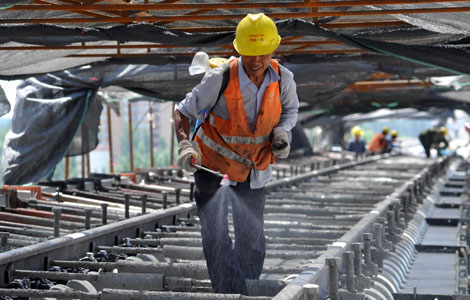Balancing the economy
Updated: 2013-07-17 09:15
(China Daily)
|
||||||||
Premier Li Keqiang said on Tuesday that the nation will pursue a balance between economic stabilization and restructuring despite the ample cards available to bolster the economy. Such confidence-building talk shows that policymakers are keeping their stimulus powder dry and further reforms still high on their agenda.
At a time when the economy is experiencing a gradual slowdown and the vacillating financial market and corporate sector are concerned about the economic prospects in the second half of this year, Li's comments offer much-needed reassurance.
Although figures such as retail sales and industrial output offer some relief, as they remain at relatively high levels, the low growth figure for the second quarter - which dropped to 7.5 percent - has nevertheless reinforced concerns that the Chinese economy is encountering serious difficulties. And the situation could get worse if the government's non-stimulus stance remains rigid.
The latest comments from Li, which are largely in line with what he said earlier this month when he met with regional leaders, is an unequivocal sign that policymakers will be pragmatic and the country still has much room to maneuver to stabilize economic growth.
Despite the many controversies surrounding the last stimulus measures launched four years ago, policymakers remain open to the possibility of another round - although of a different nature - if necessary. And they have the capability. For example, they can still rely on increasing investment to keep the economy moving, but will ensure the investment is not directed to industries that suffer from overcapacity. Instead, it will be made to flow into such sectors as affordable housing, railways, energy conservation and high tech industries.
Tax cuts and reform of the tax system, meanwhile, can also be used to encourage consumption and provide a boost to the corporate sector. Such stimulus measures would be adequate to keep the economy on a healthy growth track, although they would be incomparable to the stimulus package introduced during the global financial crisis in 2008.
If policymakers do decide to launch new stimulus measures, the quality of growth must be at the core of their policy choices. They must seek to avoid any side effects, such as the high asset prices and excessive liquidity that were produced by the last stimulus package.
Most Viewed
Editor's Picks

|

|

|

|

|

|
Today's Top News
GSK finance head not allowed to leave
Putin puts US ties above Snowden
DPRK demands Panama free seized ship
7.75% growth possible for 2013: IMF
Bomber as rock star?
More use smartphones to access the Internet
Mandela making dramatic progress: daughter
Manila playing for 'sympathy'
US Weekly

|

|













